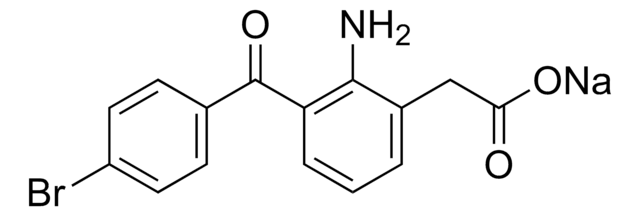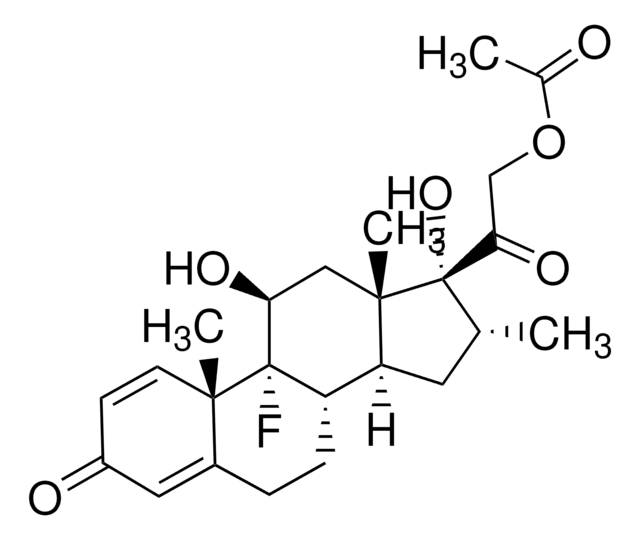D9184
Dexamethasone
meets USP testing specifications
Synonym(s):
(11β,16α)-9-Fluoro-11,17,21-trihydroxy-16-methylpregna-1,4-diene-3,20-dione, 9α-Fluoro-16α-methyl-11β,17α,21-trihydroxy-1,4-pregnadiene-3,20-dione, 9α-Fluoro-16α-methylprednisolone, Prednisolone F
About This Item
Recommended Products
biological source
synthetic (organic)
Quality Level
agency
USP/NF
meets USP testing specifications
assay
97.0-102.0%
form
solid
mp
262-264 °C (lit.)
shipped in
ambient
storage temp.
2-8°C
SMILES string
C[C@@H]1C[C@H]2[C@@H]3CCC4=CC(=O)C=C[C@]4(C)[C@@]3(F)[C@@H](O)C[C@]2(C)[C@@]1(O)C(=O)CO
InChI
1S/C22H29FO5/c1-12-8-16-15-5-4-13-9-14(25)6-7-19(13,2)21(15,23)17(26)10-20(16,3)22(12,28)18(27)11-24/h6-7,9,12,15-17,24,26,28H,4-5,8,10-11H2,1-3H3/t12-,15+,16+,17+,19+,20+,21+,22+/m1/s1
InChI key
UREBDLICKHMUKA-CXSFZGCWSA-N
Gene Information
human ... ABCB1(5243) , CYP3A4(1576) , IL4(3565) , IL5(3567) , NR3C1(2908)
mouse ... Abcb1a(18671) , Abcb1b(18669) , Ifng(15978) , Nos2(18126) , Ptgs2(19225) , Tnf(21926)
rat ... Ar(24208) , Nr3c1(24413) , Tnf(24835)
Looking for similar products? Visit Product Comparison Guide
General description
Application
- To investigate the osteogenic differentiation and chondrogenic differentiation of bone marrow mesenchymal stem cells (MSCs).
- In α-MEM (minimum essential medium) for inducing the osteogenic and adipogenic differentiation in mesenchymal stem cells from human bone marrow and umbilical cord blood.
- For the isolation and characterization of mesenchymal stem cells isolated from 6- to 8-week-old C57BL/6J mice.
Biochem/physiol Actions
signalword
Danger
hcodes
Hazard Classifications
Repr. 1B
Storage Class
6.1C - Combustible acute toxic Cat.3 / toxic compounds or compounds which causing chronic effects
wgk_germany
WGK 3
flash_point_f
Not applicable
flash_point_c
Not applicable
ppe
dust mask type N95 (US), Eyeshields, Faceshields, Gloves
Certificates of Analysis (COA)
Search for Certificates of Analysis (COA) by entering the products Lot/Batch Number. Lot and Batch Numbers can be found on a product’s label following the words ‘Lot’ or ‘Batch’.
Already Own This Product?
Find documentation for the products that you have recently purchased in the Document Library.
Customers Also Viewed
Our team of scientists has experience in all areas of research including Life Science, Material Science, Chemical Synthesis, Chromatography, Analytical and many others.
Contact Technical Service








